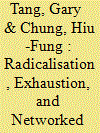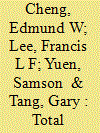|
|
|
Sort Order |
|
|
|
Items / Page
|
|
|
|
|
|
|
| Srl | Item |
| 1 |
ID:
188951


|
|
|
|
|
| Summary/Abstract |
Following the post-material shift of post-industrial societies, an evolution in citizenship norms from dutiful citizenship to engaged citizenship has occurred. This paper examines how people’s attitudes towards the Anti-Extradition Bill movement are related to these two citizenship norms. Using data collected from a population survey (N = 817), this paper shows that the people supporting the movement and radicalism perceived dutiful citizenship to be less important and engaged citizenship to be more important. The compatibility between the two sets of citizenship was found to be stronger among the people who supported the movement, despite the frequent appearance of unlawful behaviour in the movement. To explain the moderating effect, observations from focus group interviews revealed that some people had a traumatic experience in the movement. This trauma led them to doubt the legitimacy of the authority. Therefore, although they perceived dutiful citizenship to be important, they could also support various unlawful behaviours that occurred in the movement.
|
|
|
|
|
|
|
|
|
|
|
|
|
|
|
|
| 2 |
ID:
190187


|
|
|
|
|
| Summary/Abstract |
Between the Umbrella Movement in 2014 and the unprecedented mass protests in 2019, Hong Kong experienced a period of movement abeyance during which localism became a prominent political identification, notably among young people. Localism, defined as a reactive form of radicalism, was one pathway after a cycle of contention, alongside persistence with moderate claims and exhaustion, an affective process of detachment from contentious politics after mobilisation. However, the existing literature seldom explores individual attributes to these pathways during movement abeyance. Using survey data gathered from five local universities (N = 1,365), this study seeks to examine how cognitive appraisal of previous protest events, political emotions, and media use during abeyance predict radical and moderate political identifications among university students in Hong Kong. Youths with stronger devotion to the Umbrella Movement and negative emotions after it were more likely to identify as localists. However, youths with these attributes who perceived negative consequences of the Umbrella Movement showed a lower likelihood of being localists or pan-democrats. These results can elucidate the trajectories for radicalisation and exhaustion during post-Umbrella Movement abeyance.
|
|
|
|
|
|
|
|
|
|
|
|
|
|
|
|
| 3 |
ID:
186936


|
|
|
|
|
| Summary/Abstract |
This article examines the origins and dynamics of an extraordinary wave of protests in Hong Kong in 2019–2020. Despite lacking visible political opportunities and organizational resources, the protest movement drew resilient, mass participation unparalleled in the city's history and much of the world. Drawing from original on-site surveys and online datasets, we conceptualize the Anti-Extradition Law Amendment Bill Movement as a form of “total mobilization from below.” The totality of the mobilization depended on a set of interactive mechanisms: abeyant civil society networks concealed after the 2014 Umbrella Movement were activated by threats over extradition and institutional decay, whereas affective ties developed through conflicts and mutual assistance were amplified by digital communication. The movement's characteristics in terms of protest scale, mobilizing structure, use of alternative spaces, and group solidarity are examined. The spasmodic moments of mobilization are explained by a nexus of network building that took place in an unreceptive environment and at a critical juncture. The roles of threats and emotions in mass mobilizations are also analysed.
|
|
|
|
|
|
|
|
|
|
|
|
|
|
|
|
|
|
|
|
|